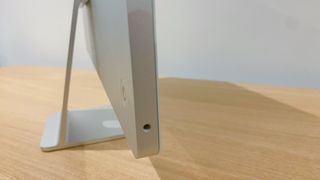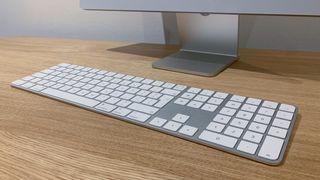IT Pro Verdict
Pros
- +
Excellent all-round computing performance with Apple Silicon
- +
High quality display
- +
Quiet operation
Cons
- -
16GB ram limit
- -
Just two USB-C ports on entry-level configuration
- -
Only supports a single external display








In 2020 Apple began transitioning its Mac range from using Intel processors to its own custom Arm chips, otherwise known as the Apple M1 platform. This architecture has breathed new life into the Mac series, offering much faster performance while reducing power consumption, heat and fan noise.
The 2021 iMac is the first Mac with Apple silicon to come with an entirely new look and appearance; one that takes advantage of the additional thermal headroom and internal space afforded by moving more internal components into Apple’s custom SoC.
Apple 24in iMac (Apple M1, 2021) review: Design
In a nod to the unique multi-coloured appearance of Apple’s original iMac G3, the 2021 model reintroduces a wider choice of colours to the line, replacing the brushed aluminium that has been associated with iMacs for well over a decade.
It’s now available in a choice of six two-tone colours or plain silver, with the rear of the chassis using a brighter, more saturated shade while the front “chin” below the display uses a lighter pastel variant. The display itself is surrounded by thinner bezels than its predecessor, now in white rather than the black of the previous design.
The retention of the large chin beneath the screen is likely to disappoint those who were hoping to see a bezel-free iMac, but it does serve a purpose: it houses the computing guts of the machine. The rest is screen, and with a depth of just 11.5mm and weight of 4.5kg, the new 24in iMac is no heavier or thicker than a standard PC display. It’s astonishingly light and can be moved around a tabletop quite easily.

The new design retains the solid quality and well-built feel of its predecessor in every way. It’s a radical change from the aluminium and black look, which was becoming stale after remaining unchanged for so many years. One slight design disappointment is that - as with the previous iMac - the stand tilts forward and backwards but cannot be raised and lowered. For that, you need a VESA mount, but this has to be chosen when ordering the iMac and can’t be installed after purchase.
Apple 24in iMac (Apple M1, 2021) review: Display
The Apple 2021 24in iMac gets an increase in pixel count and screen size over the 21.5in Intel iMac, to a new 4.5K Retina (4480 x 2520) screen, with a PPI of 218. Similar to recent redesigns of the iPhone, iPad and other Macs, through shrinking the bezels, Apple has increased the screen area without making the iMac any physically larger than its 21.5in predecessor.
The display quality is excellent. With the True Tone setting turned off, we measured a maximum brightness of 496 cd/m2, 100% coverage of the sRGB colour gamut, 98% DCI-P3 coverage and a DeltaE of 0.88, making it effectively perfect as far as accuracy goes. The image quality looks great, and will make an excellent choice for general photo editing, as well as colour grading in video and animation work.
Apple 24in iMac (Apple M1, 2021) review: Specs and Performance
Apple is selling its 24in iMac in three tiers, ranging from £1,249 to £1,649 inc VAT. All three use the same M1 chip found in the 2020 MacBook Air, MacBook Pro and Mac mini, and now the iPad Pro. The lowest tier limits your colour choice to red, green, blue and silver, but it also has two fewer ports at the back, lacks Touch ID and the ethernet port.
Teardown videos have also revealed a few undocumented differences between the lowest tier 2021 iMac and the upper-end models. For example, the base £1,249 model has just a single fan, while the higher tiers have two - which may impact its ability to cope with strenuous workloads.

As standard you get 8GB of memory, which can only be configured up to a maximum of 16GB. Storage options, meanwhile, start at 256GB and go up to 2TB. The base model M1 has 7 GPU cores compared with 8 cores on the higher tiers, but the extra GPU core in the higher tiers only makes a marginal difference in graphics performance. The wider choice of colours opens up some new options (such as purple) that may be more appealing to some people. The ethernet port, Touch ID, additional fan and extra USB-C ports are similarly likely to appeal to more performance-hungry users, but in general the base model iMac offers a reasonable level of capability.
So is it worth opting for the higher memory allocation? The M1 chip is more accurately described as an SoC, with the GPU and LPDDR4 memory integrated into the same package as the CPU. Unlike in x86 desktop PCs, M1 uses a pool of unified memory, shared and accessible by all other components in the SoC, not copied to different locations across various buses.
Because of this, memory in M1 is more efficient than in x86 architectures, and Apple says it “dramatically improves performance and power efficiency”. It’s tricky to know for sure by directly comparing Intel and M1 Mac memory performance, but even just 8GB seems remarkably efficient in M1 Macs, handling tasks such as 4K video playback in multiple browser tabs without breaking a sweat. A limit of 8GB of RAM certainly won't ever get in the way for everyday tasks, or even for many design tasks.
But as is traditional with Apple devices, no components can be upgraded after purchase, including the system memory. Extra storage can always be added via external drives, but if you plan on holding on to your iMac for a few years, to ensure better performance with demanding software of the future, we’d recommend choosing a £200 upgrade from 8GB to 16GB over anything else, even though you won't see much difference right now in daily use.
Our test 2021 iMac was a top-end model upgraded with 16GB RAM and a 1TB SSD, which we were able to compare with the most powerful Intel iMac currently available: a 2020 27in model with a 10-core 10th-generation Intel processor, 64GB of RAM and an AMD Radeon 5700XT.

This 2020 Intel-powered iMac cost around twice as much as our 24in test machine, and over three times as much as the base model. Nevertheless, in the single-core Geekbench 5 test, which is optimised for M1, the 2021 iMac trounced the Intel, delivering a very impressive score of 1,748 - roughly 40% higher. As expected though, the Intel’s dedicated graphics hardware resulted in 53,933 points in the OpenCL test, compared with 19,325 for the 2021 iMac. And with more physical CPU cores, the Intel scored 9,267 in the multi-core test, beating the 2021 iMac’s score of 7,681.
Where M1 truly shines though is in power and thermal efficiency, and significantly less fan noise. The 2021 iMac idles at 26 degrees, compared with a very warm 62 degrees for the Intel, which shoots up rapidly when under load, causing the fans to spin loudly. Even while stressed, the fans remained absolutely silent on the 2021 iMac in all but one of our tests, which was the first time we had ever heard fan noise on an M1 Mac.
Additionally, while our usual Intel-based benchmarks show highly respectable scores that can match dedicated x86 hardware, the true performance of Apple silicon is only unlocked when using applications that have been recompiled to support the new architecture, rather than emulating x86 software through Rosetta 2.
Unsurprisingly, all Apple’s own applications run directly on M1, including heavy-duty media tools such as Logic and Final Cut Pro. Popular third party software such as Microsoft Office, the Adobe suite, Da Vinci Resolve, Ableton, and browsers like Chrome and Firefox are gradually adding support through updates, and in all cases it makes a dramatic improvement to performance.
While most of our tests completed without a problem, we ran into an issue with the Heaven benchmark, which refused to run at high detail settings. The same problem arose on another M1 Mac we tested, but the same test completed without any issues on the Intel iMac.
Apple 24in iMac (Apple M1, 2021) review: Ports and Features
One further change with the new iMac design is the switch to USB-C for all its ports, mirroring the switch Apple made a few years ago with its laptops. Gone, too, is the SD card slot, so unless you already have a USB-C docking solution, you’ll likely need to invest in some dongles.

The power supply has also moved outside the iMac, supplied as an external power brick, connecting to the back of the iMac via a proprietary magnetic connector. This also houses the iMac’s Gigabit ethernet port - unless you opt for the entry-level configuration, on which it is omitted.
Two of the iMac’s USB-C ports support 40GB/sec Thunderbolt. These are all you get on the base model, with two additional USB-C ports that support USB 3.1 Gen 2 10GB/sec on the higher tiers. You may still need a dock, dongle or hub if you rely on older USB-A peripherals. Wi-Fi 6 comes as standard, and with a decent router and good wireless coverage, most people won't miss the ethernet port on the base tier 24in iMac.
The bundled Magic Mouse (or Magic Trackpad) is coloured to match the design of the iMac. Apple’s Magic Keyboard, meanwhile, has had a small upgrade with the addition of a Touch ID fingerprint sensor, that can be used for authentication in MacOS. It’s a nice, but not essential, part of the iMac package, coming as standard in the higher tiers.
Otherwise the included peripherals are unchanged from previous generations. Irritatingly, this means the mouse’s internal battery must still be recharged via a Lightning port on the underside, which makes it impossible to use while charging.
As with all M1 Macs, the 2021 iMac has a further limitation of only a single external display, connected via Thunderbolt. That means at most you can only ever have two screens. It’s unlikely to be a problem for the majority of people, but for power users who prefer triple-screen setups, this limitation may be one reason to wait for a larger iMac with an M1 Pro or M1 Max SoC.
The front-facing webcam finally offers 1080p resolution, but lacks iOS 15’s superb Center Stage feature that follows the user around a room.

The speakers are excellent quality for an all-in-one of this size, and are light years ahead of the sound quality of most standalone displays. Audiophiles may still opt for an external audio setup, but for average users this will be an auditory treat.
Apple 24in iMac (Apple M1, 2021) review: Verdict
Don’t be put off by the mid-range pricing and colourful, accessible appearance of the 2021 iMac. In all situations, it delivers serious performance that makes it suitable for serious work, including video, audio and image editing.
iMacs have traditionally been appealing as general home desktops, but also in art and design, certain education environments and some offices too. The 2021 iMac is likely to continue to remain popular in these settings. It’s everything most people will need from a Mac desktop, and a fantastic success for Apple’s new architecture.
For power users it has a few limitations - most notably a maximum 16GB of RAM and a single external display. On M1 Macs, most applications designed for Intel processors work flawlessly through Rosetta 2, and the majority of popular applications have already been updated to run natively on the M1 architecture. But as we found, there are a few exceptions where the experience may not be so smooth. Some older software and more obscure applications may cause problems.
There’s a larger iMac coming in 2022 that will probably be powered by the M1 Pro and M1 Max processors first seen in last year’s MacBook Pro models, which will raise the maximum memory capacity and support more displays. Some people are no doubt waiting for this more powerful version, but with a solid, svelte new design, excellent screen quality, all-round fantastic performance and palatable entry-level price, the latest 24in iMac is still a fantastic computer in its own right.
Apple 24in iMac (Apple M1, 2021) specifications
| Processor | Apple M1 |
| RAM | 8GB - 16GB |
| Graphics adapter | Apple M1 |
| Storage | 256GB - 1TB |
| Screen size (in) | 23.5 |
| Screen resolution | 4,480 x 2,520 |
| Screen type | 4-inch 4.5K Retina display |
| Touchscreen | none |
| Pointing devices | Apple Magic Mouse |
| Memory card slot | No |
| 3.5mm audio jack | Yes |
| Graphics outputs | 2x Thunderbolt 3 / USB 4 (one external display) |
| Other ports | 2x USB-C |
| Web Cam | 1080p |
| Speakers | Six-speaker system with force-cancelling woofers |
| Wi-Fi | Wi-Fi 6 |
| Bluetooth | Bluetooth 5.0 |
| NFC | none |
| Dimensions, mm (WDH) | 54.7 cm x 14.7 cm x 46.1 cm |
| Weight (kg) - with keyboard where applicable | 4.48 kg |
| Battery size (Wh) | none |
| Operating system | MacOS |